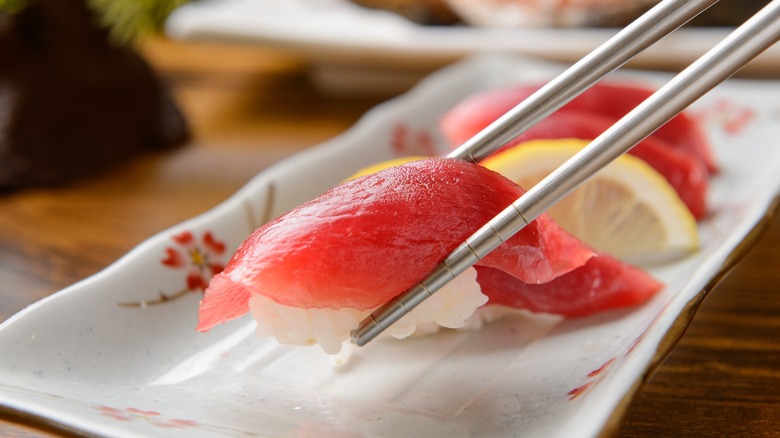Bluefin tuna sashimi is often considered the pinnacle of sushi delicacies, sought after by seafood connoisseurs and sushi lovers around the world. Renowned for its rich, buttery flavor, silky texture, and vibrant color, bluefin tuna stands as one of the most prized offerings at sushi counters and fine-dining establishments. Its popularity, however, extends beyond taste; it represents centuries of Japanese culinary tradition and a dedication to quality and artistry.
The History of Bluefin Tuna in Japanese Cuisine
Bluefin tuna has been a revered part of Japanese cuisine for centuries, traditionally prepared and enjoyed as sashimi—a dish consisting of thinly sliced, raw seafood served without rice. While sushi became globally popular in the late 20th century, the Japanese art of preparing and serving sashimi dates back much earlier, embodying respect for the sea and a commitment to quality and freshness. Bluefin tuna sashimi has grown in prominence as global palates have developed an appreciation for the refined art of raw seafood preparation.
What Makes Bluefin Tuna Special?
Bluefin tuna (Thunnus thynnus) is widely considered one of the highest-quality fish for sashimi due to its:
- Exceptional Flavor: Bluefin tuna has a unique, buttery taste that becomes more complex as it melts on the tongue.
- Marbling: Much like the finest cuts of beef, bluefin tuna is prized for its marbling of fat within the flesh. This marbling provides a velvety texture and adds to its luxurious profile.
- Versatility: Different parts of the bluefin tuna offer a range of textures and flavors, making it a versatile choice for sashimi.
Grading Bluefin Tuna: Understanding Quality
Bluefin tuna is graded according to several factors that determine its quality:
- Color: The color of the flesh, ranging from a deep ruby red to a rich marbled pink, indicates freshness and fat content.
- Fat Content: The level of fat, or “toro,” is one of the most important indicators of quality. The two main types are:
- Chutoro (Medium Fatty Tuna): Found on the belly, chutoro offers a balance of lean meat and rich fat.
- Otoro (Fatty Tuna): The most luxurious cut, otoro is exceptionally tender and marbled, often melting in the mouth.
- Texture and Firmness: Fresh bluefin tuna should be firm but pliable, with a texture that is both delicate and satisfying.
The Art of Preparing Bluefin Tuna Sashimi
The preparation of bluefin tuna sashimi requires skill, precision, and a respect for the fish:
- Slicing Techniques: Expert sushi chefs use special knives to create precise cuts that maximize the flavor and texture of each slice. The slices should be uniform, with clean edges.
- Chilling: Bluefin tuna is often chilled or slightly frozen before slicing to enhance its texture and allow for easy cutting.
- Presentation: Traditionally, sashimi is served on a clean, minimalist plate, often accompanied by garnishes like shiso leaves, pickled ginger, and freshly grated wasabi to enhance the dining experience.
Flavor Profile of Bluefin Tuna Sashimi
Bluefin tuna sashimi offers a complex flavor profile that blends the natural sweetness of the fish with its creamy, buttery fat. The taste evolves as it warms in the mouth, releasing layers of umami and a subtle brininess reminiscent of the ocean. The experience is often described as decadent and satisfying, a true reflection of the bluefin’s luxurious reputation.
The Cultural Significance of Bluefin Tuna
In Japan, bluefin tuna is more than just a delicacy; it is a cultural symbol. The traditional preparation of sashimi represents craftsmanship, respect for the ingredients, and the artistry of Japanese cuisine. Tuna auctions at Tokyo’s Toyosu Market capture the global fascination with this fish, often featuring record-breaking bids that emphasize its value and status.
Ethical Considerations and Sustainability
The popularity of bluefin tuna has led to overfishing, raising significant concerns about the species’ sustainability. Conservation efforts have emerged to protect bluefin tuna populations, such as catch limits, sustainable aquaculture initiatives, and traceable sourcing programs. For eco-conscious diners, seeking out responsibly sourced bluefin tuna is essential for supporting the preservation of this remarkable fish.
Enjoying Bluefin Tuna Sashimi at Home
Preparing bluefin tuna sashimi at home can be a rewarding experience for those who want to explore the world of sushi-making:
- Source Quality Fish: Purchase bluefin tuna from reputable sources that specialize in sashimi-grade fish.
- Use Proper Tools: A sharp knife is crucial for creating clean slices without tearing the delicate meat.
- Practice Safety: Ensure the fish is kept at a proper temperature to prevent any bacterial growth.
Pairing Bluefin Tuna Sashimi
Bluefin tuna sashimi pairs beautifully with a variety of beverages and sides:
- Sake: A high-quality junmai or junmai daiginjo sake complements the subtle richness of the tuna.
- White Wine: A crisp, dry white wine, such as Sauvignon Blanc, offers a refreshing counterpoint to the sashimi’s richness.
- Soy Sauce and Wasabi: Traditional accompaniments, when used sparingly, enhance the flavor without overpowering the fish.
Bluefin Tuna Beyond Sashimi: Culinary Innovations
Chefs continue to experiment with bluefin tuna in modern culinary creations, incorporating it into fusion dishes and exploring new preparation techniques. From seared tataki to tuna tartare topped with caviar, these innovations showcase the versatility of bluefin tuna while maintaining a deep appreciation for its traditional roots.
Conclusion
Bluefin tuna sashimi exemplifies the art and luxury of Japanese cuisine, captivating diners with its exquisite taste, texture, and cultural significance. Each slice tells a story of tradition, craftsmanship, and a commitment to excellence. For sushi lovers, enjoying bluefin tuna sashimi is more than a meal—it is an immersive experience that honors the heritage of one of the world’s most situstoto prized delicacies. Whether savored in a high-end sushi bar or carefully prepared at home, bluefin tuna sashimi remains a premium offering that epitomizes the pinnacle of sushi artistry.
